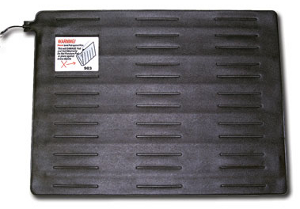Difference between revisions of "Bed and Chair Sensors"
| Line 1: | Line 1: | ||
[[File:PressureMat.png|right|frame|Bed or Chair Pressure Mat]] | [[File:PressureMat.png|right|frame|Bed or Chair Pressure Mat]] | ||
<h3 style="display: inline-block; background:#ffffff; font-weight:bold; border-bottom:2px solid #6093cc; text-align:left; color:#000; padding:0.2em 0.4em;"><br />Overview</h3> | <h3 style="display: inline-block; background:#ffffff; font-weight:bold; border-bottom:2px solid #6093cc; text-align:left; color:#000; padding:0.2em 0.4em;"><br />Overview</h3> | ||
Bed sensors can help you see whether your loved one is going to bed at normal times and staying in bed during the night. Activity graphs help you see whether your loved one is sleeping calmly or restlessly. And you can also see whether your loved one is staying in bed excessively, or returning to bed during the day. You can use these sensors on other furniture as well, such as chairs or couches.<br /><br /> | |||
<h3 style="display: inline-block; background:#ffffff; font-weight:bold; border-bottom:2px solid #6093cc; text-align:left; color:#000; padding:0.2em 0.4em;">Types of Bed Sensors</h3> | |||
Each bed sensor has two parts, a pressure mat and a contact sensor. The pressure mats come in two sizes, and there are two different models of contact sensors. Your GrandCare representative or installer should help you choose the models that are right for your needs. If those needs change, different models or devices can be added to the system at a later date. As part of the installation process, the bed sensors must be paired with your system, so that the signals are picked up properly.<br /><br /> | |||
<h3 style="display: inline-block; background:#ffffff; font-weight:bold; border-bottom:2px solid #6093cc; text-align:left; color:#000; padding:0.2em 0.4em;">How to Place a Bed Sensor</h3> | <h3 style="display: inline-block; background:#ffffff; font-weight:bold; border-bottom:2px solid #6093cc; text-align:left; color:#000; padding:0.2em 0.4em;">How to Place a Bed Sensor</h3> | ||
For accurate readings, the pressure mat shouldn't be placed under the mattress. Instead, place it under mattress pad or blanket. It should be placed under the legs or feet of your loved one, somewhere where there is likely to be contact when your loved one is in bed. The sensor is attached by wires. You may want to attach the sensor to the bed frame, being careful to place it where the wires won't tangle with your loved one's feet.<br /><br /> | |||
If you are using the sensor on a chair or couch, the pressure mat shouldn't be placed under a cushion. Instead, place the mat on top of the cushions, but cover it with a blanket or quilt for your loved one's comfort. The sensor can be tucked out of the way between the cushions.<br /><br /> | |||
Revision as of 19:25, 15 June 2012
Overview
Bed sensors can help you see whether your loved one is going to bed at normal times and staying in bed during the night. Activity graphs help you see whether your loved one is sleeping calmly or restlessly. And you can also see whether your loved one is staying in bed excessively, or returning to bed during the day. You can use these sensors on other furniture as well, such as chairs or couches.
Types of Bed Sensors
Each bed sensor has two parts, a pressure mat and a contact sensor. The pressure mats come in two sizes, and there are two different models of contact sensors. Your GrandCare representative or installer should help you choose the models that are right for your needs. If those needs change, different models or devices can be added to the system at a later date. As part of the installation process, the bed sensors must be paired with your system, so that the signals are picked up properly.
How to Place a Bed Sensor
For accurate readings, the pressure mat shouldn't be placed under the mattress. Instead, place it under mattress pad or blanket. It should be placed under the legs or feet of your loved one, somewhere where there is likely to be contact when your loved one is in bed. The sensor is attached by wires. You may want to attach the sensor to the bed frame, being careful to place it where the wires won't tangle with your loved one's feet.
If you are using the sensor on a chair or couch, the pressure mat shouldn't be placed under a cushion. Instead, place the mat on top of the cushions, but cover it with a blanket or quilt for your loved one's comfort. The sensor can be tucked out of the way between the cushions.
